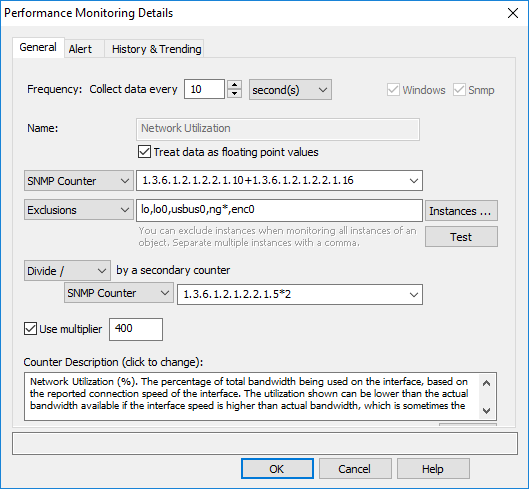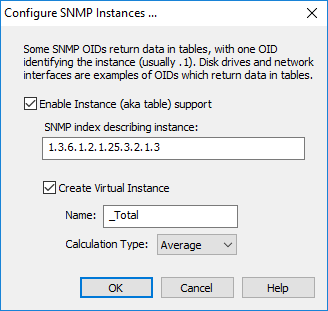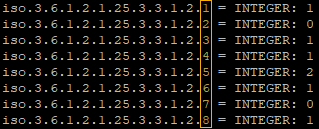SNMP Counter
Specify the OID of a SNMP counter in numerical form, e.g. 1.3.6.1.4.1.2021.11.9.0. Basic arithmetic like addition, subtraction, multiplication and division are supported. SNMP values are polled by the heartbeat agent.
|
Variables are supported for the SNMP Counter field. For example, if you have some devices supporting only SNMP v1, and some supporting SNMP v2c and higher, then you can still use a single performance counter and just override the default OID on a per-host or per-group level. This is useful for networks running multiple versions of SNMP and OIDs that differ between various SNMP versions. |

Calculate the network bandwidth and exclude certain instances
Inclusions / Exclusions
If a SNMP counter is organized as a table (aka SEQUENCE), then specific "instances" can be included or excluded if the OID describing the instance names is configured through the Instances button. When enabling an instance, the index describing the actual instances is required so that data collected by the instances can be distinguished.
|
If the instance type is set to Include and only one instance is specified, a SNMP-based counter is treated like regular SNMP counter, and the instance name will not be stored in the database. |
In the example below, all instances are listed under 1.3.6.1.2.1.31.1.1.1.1, with each row of the table describing a network interface.
When an instance is defined, one or more instances can be excluded, or specific instances can be included.

Calculate with a secondary counter
Some SNMP counters provide additional insight when their values are used in combination with another performance counter. You can add, subtract, divide or multiply the obtained values of a SNMP counter with/by the values by of a "secondary" SNMP counter.
Since SNMP counters do support basic arithmetic, the example above could also be calculated with the use of a secondary counter, by specifying the following in the primary SNMP counter field:
(1.3.6.1.2.1.31.1.1.1.6+1.3.6.1.2.1.31.1.1.1.10)/(1.3.6.1.2.1.31.1.1.1.15*1600000000)
Testing
A SNMP counter can be tested by clicking the "Test" button and specifying a SNMP-enabled remote host. If the remote host responds to SNMP GET requests, the current data will be displayed on the bottom of the dialog and updated in regular intervals. If the specified computer is already present in an EventSentry group, then any authentication settings applied to that host will be automatically used when sending the SNMP GET request.
Counter Description
Resolves the specified OID(s) using the MIBs configured on the SNMP Trap Daemon dialog.
SNMP Instances
Enable this option when a SNMP OID returns data in a table, meaning multiple instances for the same counter are provided. This usually applies to performance metrics from hardware components like network cards or CPUs, where multiple instances of the same type of performance source exist. The image below shows an example of SNMP data (current CPU utilization by each core from a VMWare(c) host) returned in a table:

SNMP Index: Since data values returned in a table may be missing context they can be associated with another table that describes those values, as shown in the image below. The table describing the instances can be located anywhere in the SNMP tree as long as the indexes (highlighted in yellow) match.

Virtual Instances
A virtual instance is an additional instance (table row) that is created on the fly, with its value being calculated from the existing SNMP values. The value of the virtual instance can either be the average or sum of all existing values. For example, the _Total instance, which is normally only available on Windows-based hosts, can be created on VMWare(c) hosts by averaging the current CPU utilization of all cores.
Name: The name of the virtual instance
Calculation Type: Average or sum of all values

